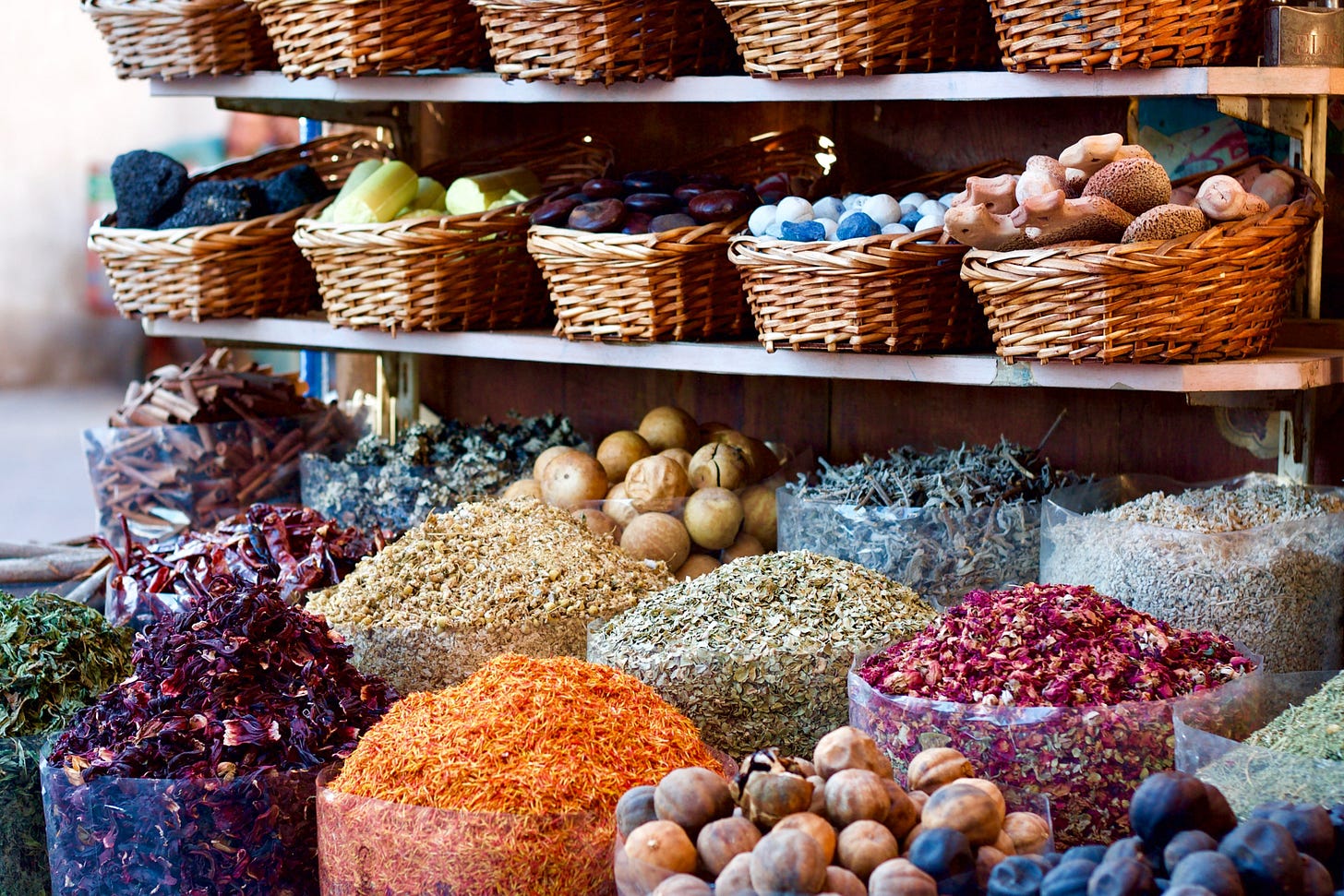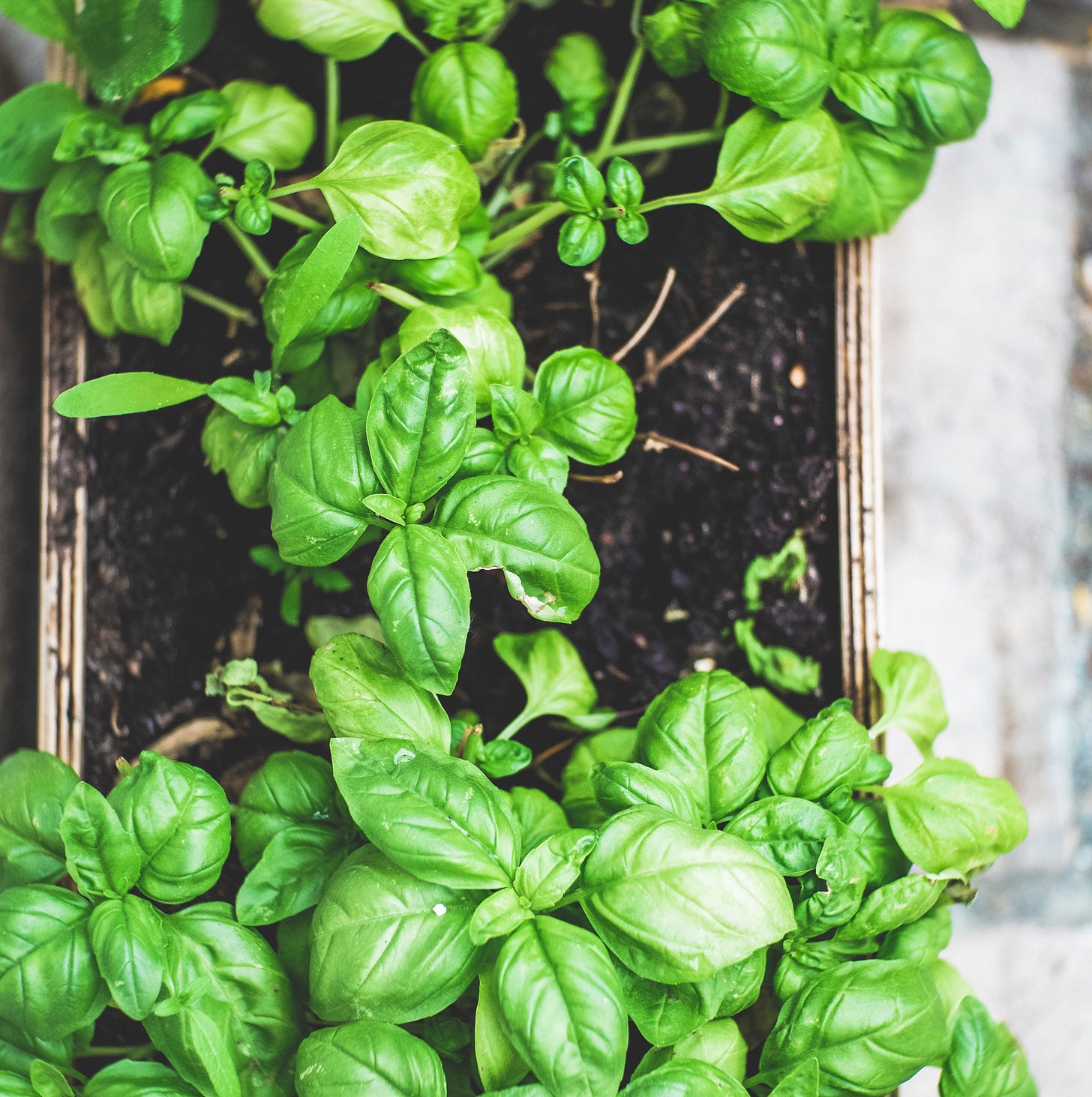The first time I realized that traditional herb-food pairings were about more than just flavor, it felt like an enormous breakthrough. Of course I knew the common anecdotes about green salads helping with digestion…but the idea that certain herbs could actually help us digest particular foods? That seemed crazy.
It all started when I was reading Wolf D. Storl’s amazing book The Herbal Lore of Wise Women and Wortcunners, specifically, this paragraph:
“The kitchen herbs, easily grown in one’s garden or on the windowsill, are rich in flavors, vitamins, and ethereal oils and have very little bulk. Thus they are yang/cosmic/solar and can be used to balance out the heavy, bulky foods that give us our calories (carbohydrates and proteins) and are derived from the yin/terrestrial/lunar side.”
What Storl goes on to explain, are the many ways that culinary herbs help our bodies—specifically when it comes to the healthy digestion of the foods they’ve traditionally been paired with.
As it turns out, food-herb pairings are about more than flavor, and there’s very likely a biochemical reason our ancestors combined things like dill and fish, or chili and beans.
One of the many aspects of our cultural amnesia lies in our forgotten knowledge of plants1. While our great grandmothers knew (out of necessity) which herbs to pluck from the garden to treat certain ailments, the ease with which we go about our day-to-day lives (hello grocery stores!) doesn’t necessitate that same kind of knowledge.
Most of us no longer live off the land, and as a result— we’ve lost our collective plant wisdom. Part of my goal with this newsletter is to provide backstreets and byways through which you can rediscover the ancestral knowledge of your people and community. In this letter, we’ll dive into the forgotten history of three common kitchen herbs, as well as the biochemical rationale behind the foods we pair them with.
1. Dill
Dill (Anethum graveolens L.) is often paired with fatty foods like fish, as well as starched-based meals—like BBQ-style potato salad. Since these heavier meals can be hard to digest, it makes sense to season them with an herb like dill—which has been used as a stimulating aromatic carminative2 since ancient times.
Traces of dill have been found in Roman ruins, with further evidence pointing to its medicinal use in Egypt over 5,000 years ago. Even today, dill is often prescribed in Ayurvedic medicine for abdominal discomfort, colic, and help with digestion3.
So what is it about this wondrous kitchen herb that gives it so much healing power? Mainly, it has to do with the herb’s essential and volatile oils. While essential oils in dill seed can relieve intestinal spasms and settle colic, the carminative volatile oils within the plant can also improve appetite and relieve gas4.
2. Horseradish
From Sauerkraut to certain brands of mustard5— there’s at least one ingredient these beef-loving condiments have in common, and that’s horseradish (Armoracia rusticana). This powerful root, which dates back to ancient Egypt, has been used over the millennia to address a myriad of ailments from lower back pain to indigestion.
Although many consider it to be an acquired taste, there’s several reasons you may want to start incorporating horseradish into your favorite protein-rich meals. As a cholagogue, horseradish supports liver function by working within the gall bladder to release bile—a key part of healthy digestion. Certain constituents of horseradish have also been known to speed up metabolism of protein6.
3. Basil
Often scattered across Margherita pizzas or finely chopped in savory tomato sauces, there’s yet another reason (besides the incredible flavor) that basil (Ocimum basilicum) is a key component of so many classic Italian dishes.
Due to a high concentration of essential oils like eugenol, linalool, and citronellol, basil acts as a powerful anti-inflammatory7. With the number of people experiencing dairy and nightshade8 allergies, consuming these foods alongside an anti-inflammatory herb like basil could prove useful. But basil may actually be protecting us from more than just the cheese and tomatoes.
A 2017 study found that basil could also be effective against inflammation caused by oxidative stress9. Oxidative stress comes from an overabundance of free radicals, which are rogue, erratically behaving molecules brought on by a diet rich in refined carbohydrates and sugars. Read: pizza, pasta, and yes—even your favorite tiramisu.
The last bite
There’s still so much relearning to do if we want to get back to a place of truly understanding plant medicine, and all the ways its been enacted throughout the ages. But digging deeper into the science behind historical food-herb pairings offers a great start. Get curious the food-herb pairings that come across your plate. There’s a forgotten wisdom in our food traditions, and if we’re curious enough—there’s no limit to what we might remember.
Photos by Nikhita Singhal, KTRYNA, Markus Spiske.
As an Amazon Associate, I earn a small percentage from qualifying purchases made through this post.
To learn more about this subject, I highly recommend Sajah Popham’s book Evolutionary Herbalism: Science, Spirituality, and Medicine from the Heart of Nature.
Cech, Richo. Making Plant Medicine. Herbal Reads, 2016.
Jana, S., & Shekhawat, G. S. (2010). Anethum graveolens: An Indian traditional medicinal herb and spice. Pharmacognosy reviews, 4(8), 179–184. https://doi.org/10.4103/0973-7847.70915
Jana, S., & Shekhawat, G. S.
Funny enough, mustard and horseradish are actually part of the same plant family and share many medicinal qualities.
Easley, T., & Horne, S. H. (2016). The Modern Herbal Dispensatory: A Medicine-making Guide. Berkeley, California: North Atlantic Books.
www.webmd.com/diet/health-benefits-basil
Tomato is a member of the nightshade family.
Li, H., Ge, Y., Luo, Z., Zhou, Y., Zhang, X., Zhang, J., & Fu, Q. (2017). Evaluation of the chemical composition, antioxidant and anti-inflammatory activities of distillate and residue fractions of sweet basil essential oil. Journal of food science and technology, 54(7), 1882–1890. https://doi.org/10.1007/s13197-017-2620-x












